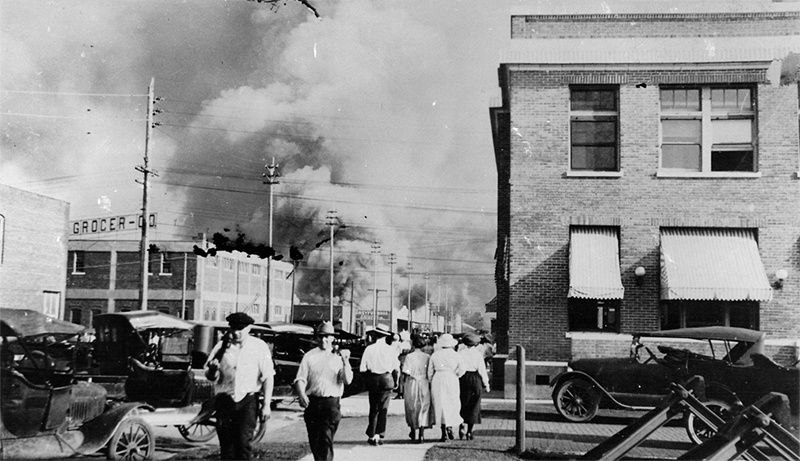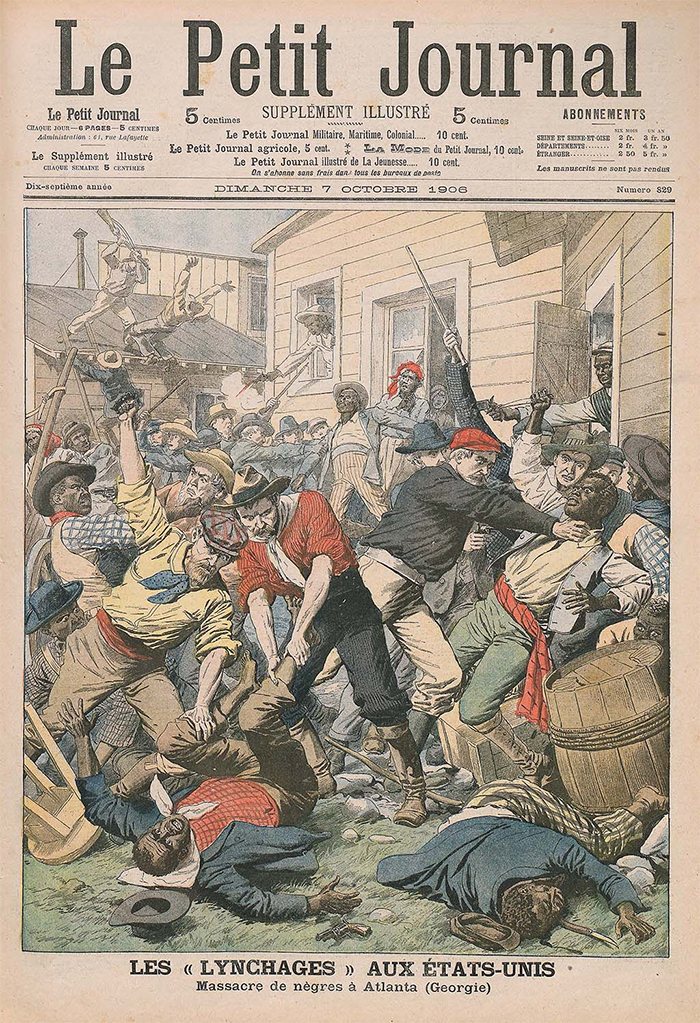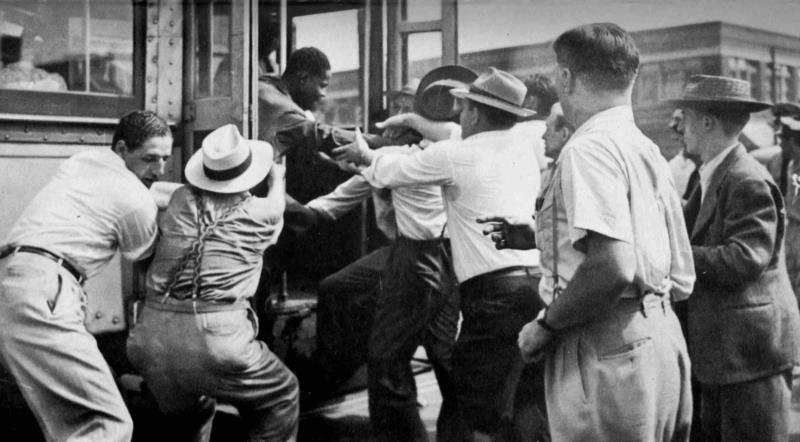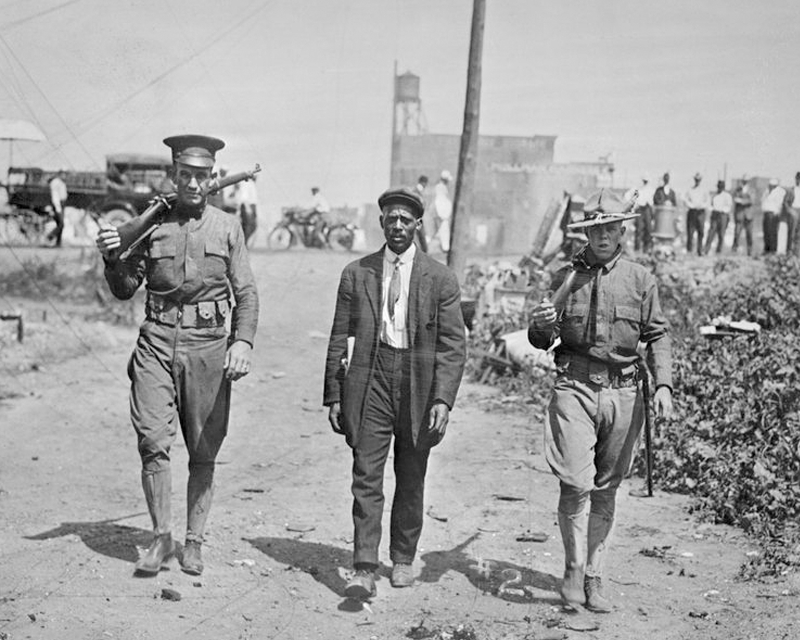Did you ever wonder if the Greenwood district of Tulsa was the only prosperous African-American community? We have taken the time to search and compile the history of other such enclaves. The historical facts unveil a minimum of 7 additional African-American communities that were thriving and self-determined to succeed and succeed they did.
The following revelations illustrate Black people can excel in excellence at anything they focus and energize as a cohesive collective.
Unfortunately there is a broad girth of whites that find black success a tax on their capacity to attain and retain their wealth. That mindset is selfish and dangerous at best. A person would think such provocations would end in mutual calamity with a total spectrum of retaliatory consequences against the provocateurs.
The ongoing tests of African-Americans resilience to systemic oppression should be a testament positive change is on the horizon.
Massacre of Black Sharecroppers That Led the Supreme Court to Curb the Racial Disparities of the Justice System
White Arkansans, fearful of what would happen if African-Americans organized, took violent action, but it was the victims who ended up standing trial.
The sharecroppers who gathered at a small church in Elaine, Arkansas, in the late hours of September 30, 1919, knew the risk they were taking. Upset about unfair low wages, they enlisted the help of a prominent white attorney from Little Rock, Ulysses Bratton, to come to Elaine to press for a fairer share in the profits of their labor. Each season, landowners came around demanding obscene percentages of the profits, without ever presenting the sharecroppers detailed accounting and trapping them with supposed debts.
“There was very little recourse for African-American tenant farmers against this exploitation; instead there was an unwritten law that no African-American could leave until his or her debt was paid off,” writes Megan Ming Francis in Civil Rights and the Making of the Modern American State. Organizers hoped Bratton’s presence would bring more pressure to bear through the courts. Aware of the dangers – the atmosphere was tense after racially motivated violence in the area – some of the farmers were armed with rifles. READ MORE
Atlanta Race Riot (1906)
The Atlanta Race Riot or Atlanta Riot of 1906 was the first race riot to take place in the capital city of Georgia. The riot lasted from September 22 to September 24 and was the culmination of a number of factors, including lingering tensions from reconstruction, job competition, black voting rights, and increasing desire of African Americans to secure their civil rights.
By 1900 the population of Atlanta had more than doubled to 89,872 from its 1880 level. The black population nearly quadrupled during that period. Job competition became intense and white politicians responded by implementing and expanding Jim Crow laws. The laws maintained separate black and white neighborhoods, segregated public transportation, and segregated schools. Despite these hurdles, a small number of black families achieved a significant measure of success. Black men voted during Reconstruction and continued to do so after their counterparts were pushed off the rolls throughout the rest of the South. Consequently there was considerable African American political activism in the city. The growing black middle class made many white citizens uncomfortable but they were also wary of rising crime rates and the perceived threat of black men against white women.
The 1906 gubernatorial campaign added fuel to the racial fire, as both Democratic candidates, Hoke Smith and Clark Howell, advocated disenfranchisement of all black voters in their respective newspapers. On September 22, after four alleged sexual attacks on white women by black men were reported in the local white press, a mob of approximately 10,000 white men formed downtown. The mob surged through black Atlanta neighborhoods destroying businesses and assaulting hundreds of black men. The violence became so dangerous that the state militia was called in to take control of the city. Still, some white groups persisted in attacking black neighborhoods, and black men organized to defend their homes and families.
Red Summer In Chicago: 100 Years After The Race Riots
Exactly 100 years ago, Chicago was in the throes of a brutal heat wave. Thousands flocked to the beaches lining Lake Michigan for some relief. Among them: a group of black boys that included 17-year-old Eugene Williams. Eugene, who was on a raft, inadvertently drifted over the invisible line that separated the black and white sections of the 29th St Beach. One white beachgoer, insulted, began throwing rocks at the black kids. Eugene Williams slipped off his raft and drowned.
That incident ignited a race riot that would go down in history as one of the country’s bloodiest, and least-known, to date. And Chicago wasn’t the only place this happened. What would come to be referred to as the country’s Red Summer was a series of race riots that occurred for several months in different places around the country. In Chicago, Eugene Williams’ death was what sparked the city’s riots, but kindling for that fire had been building for at least a few years.
For one thing, the city’s demographics were changing very quickly. 100-year-old Timuel Black Jr. is a historian, educator and activist who has lived most of his long life in Chicago. He came to the city with his parents as an infant a few months after the riot, but stories from relatives and neighbors made it very clear why so many black folks were streaming into Chicago.
For more Read More Here.
ROSEWOOD MASSACRE (1923)
On January 1, 1923 a massacre was carried out in the small, predominantly black town of Rosewood in Central Florida. The massacre was instigated by the rumor that a white woman, Fanny Taylor, had been sexually assaulted by a black man in her home in a nearby community. A group of white men, believing this rapist to be a recently escaped convict named Jesse Hunter who was hiding in Rosewood, assembled to capture this man.
Prior this event a series of incidents had stirred racial tensions within Rosewood. During the previous winter of 1922 a white school teacher from Perry had been murdered and on New Years Eve of 1922 there was a Ku Klux Klan rally held in Gainesville, located not far away from Rosewood.
In response to the allegation by Taylor, white men began to search for Jesse Hunter, Aaron Carrier and Sam Carter who were believed to be accomplices. Carrier was captured and incarcerated while Carter was lynched. The white mob suspected Aaron’s cousin, Sylvester Carrier, a Rosewood resident of harboring the fugitive, Jesse Hunter.
On January 4, 1923 a group of 20 to 30 white men approached the Carrier home and shot the family dog. When Sylvester’s mother Sarah came to the porch to confront the mob they shot and killed her. Sylvester defended his home, killing two men and wounding four in the ensuing battle before he too was killed. The remaining survivors fled to the swamps for refuge where many of the African American residents of Rosewood had already retreated, hoping to avoid the rising conflict and increasing racial tension.
Read More Here.
Washington, D.C. Race Riots (1919)
The deadly race riot ‘aided and abetted’ by The Washington Post a century ago. A front-page article helped incite the violence in the nation’s capital that left as many as 39 dead.
The man attacked Louise Simmons in the afternoon, as she was leaving the Washington school where she taught. He had ridden up on a bicycle, leapt off and started pummeling her, she said. He dragged her toward a grove of trees; Simmons fought back until she was able to escape. It’s unclear how good a look she got of his face, but she could tell that, like her, he was black.
On that day, June 25, 1919, there were four major newspapers in the nation’s capital competing for readers. The Washington Herald published a small item about the attack on Simmons on page two, under the headline “Negro attacks negress.” The Washington Times ran a longer story but buried it in the back of the paper. The Evening Star and the smallest paper of the four — The Washington Post — didn’t mention it.
What followed was weeks of hysteria ginned up by the media, the arrest of hundreds of innocent black men, a riot that left as many as 39 dead and 150 injured, and put two black men in prison for decades for crimes they most likely did not commit.
Read More Here.
Knoxville, Tennessee Race Riots (1919)
Maurice Mays And The Knoxville Race Riots: A Tragedy Forgotten>
Knoxville has quite a bit of history rooted in Civil Rights. There are also untold stories of our past which have continued to set patterns throughout time. The story of Maurice Franklin Mays is one that brings awareness to the continued systemic disenfranchisement of black men within the justice system and a case that would affect the state of the black community in the city. It’s also a story forgotten.
The time period known as the Red Summer of 1919 was a busy year and produced lynchings, heavy race rioting across the country and in the City of Knoxville. It has been cast by some as the second to third largest riot ever recorded and one of the worst racial episodes in Knoxville’s history. It shattered the city’s vision of itself as a racially tolerant Southern town. Many today believe it contributed to the lack of diversity that currently presides.

The tragedy was fueled by the case of Maurice Mays, a well-known black man who grew up in Knoxville. His black foster father and mother raised him from the age of six months but the word around town was that his real father was Knoxville Mayor John McMillan, a rich white man.
Read More.
Race and Labor in the 1863 New York City Draft Riots
An enormous historical event that shaped New York City is not much spoken of today. In July 1863, about 1,200 to 1,500 men, mostly Irish dockworkers, rioted against the Civil War draft in New York City in a four-day upheaval, targeting black workers and citizens. The number of fatalities is unclear, but reports fluctuate between 100 to over 1,000. It remains the most signficant insurrection by civilians in American history.
Opposition to the Civil War was largely fueled by a fear of newly freed blacks moving north and taking over already underpaid positions, specifically as longshoremen. This fear of an “other” taking economic advantage to the detriment of “true citizens” recurs throughout history, from Nazi Germany to the current ICE raids. During his election campaign, President Donald Trump said that illegal immigrants “compete directly against vulnerable American workers.” Some argue that tapping into this fear helped secure his electoral win. Similarly, pro-slavery politicians and journalists of the mid-1800s used this fear of economic instability to their advantage and were largely responsible for promoting the rhetoric.
Read More Here.
The East St. Louis Massacre (1917)
The East St. Louis Race Riot Left Dozens Dead, Devastating a Community on the Rise. Three days of violence forced African-American families to run for their lives and the aftereffects are still felt in the Illinois city today.
No one really knows about this. . . . I know about it because my father, uncles and aunts lived through it,” Dhati Kennedy says.
He’s referring to an incident that survivors call the East St. Louis Race War. From July 1 through July 3, 1917, a small Illinois city located across the river from its Missouri counterpart was overrun with violence. Kennedy’s father Samuel, who was born in 1910, lived in East St. Louis when the conflict occurred. A smoldering labor dispute turned deadly as rampaging whites began brutally beating and killing African-Americans. By the end of the three-day crisis, the official death toll was 39 black individuals and nine whites, but many believe that more than 100 African-Americans were killed.
“We spent a lifetime as children hearing these stories. It was clear to me my father was suffering from some form of what they call PTSD,” Kennedy recalls. “He witnessed horrible things: people’s houses being set ablaze, . . . people being shot when they tried to flee, some trying to swim to the other side of the Mississippi while being shot at by white mobs with rifles, others being dragged out of street cars and beaten and hanged from street lamps.”
Read More
Greenwood, Tulsa, Oklahoma “Black Wall Street”
1921 Attack on Black Prosperity
The 1921 Attack on Greenwood was one of the most significant events in Tulsa’s history. Following World War I, Tulsa was recognized nationally for its affluent African American community known as the Greenwood District. This thriving business district and surrounding residential area was referred to as “Black Wall Street.” In June 1921, a series of events nearly destroyed the entire Greenwood area.
On the morning of May 30, 1921, a young black man named Dick Rowland was riding in the elevator in the Drexel Building at Third and Main with a woman named Sarah Page. The details of what followed vary from person to person. Accounts of an incident circulated among the city’s white community during the day and became more exaggerated with each telling.
Tulsa police arrested Rowland the following day and began an investigation. An inflammatory report in the May 31 edition of the Tulsa Tribune spurred a confrontation between black and white armed mobs around the courthouse where the sheriff and his men had barricaded the top floor to protect Rowland. Shots were fired and the outnumbered African Americans began retreating to the Greenwood District.
In the early morning hours of June 1, 1921, Greenwood was looted and burned by white rioters. Governor Robertson declared martial law, and National Guard troops arrived in Tulsa. Guardsmen assisted firemen in putting out fires, took African Americans out of the hands of vigilantes and imprisoned all black Tulsans not already interned. Over 6,000 people were held at the Convention Hall and the Fairgrounds, some for as long as eight days.
Twenty-four hours after the violence erupted, it ceased. In the wake of the violence, 35 city blocks lay in charred ruins, over 800 people were treated for injuries and contemporary reports of deaths began at 36. Historians now believe as many as 300 people may have died.
Read More
WILMINGTON RACE RIOT OF 1898 and SUCCESSFUL INSURRECTION
A politically motivated attack by whites against the city’s leading African American citizens, the Wilmington Race Riot of 1898 documents the lengths to which white Democrats went to regain political domination of the South after Reconstruction. The violence began on Thursday, November 10 in the predominantly African American city of Wilmington, North Carolina, at that time the state’s largest metropolis. Statewide election returns had recently signaled a shift in power with Democrats taking over the North Carolina State Legislature. The city of Wilmington, however, remained in Republican hands, primarily because of its solid base of African American voters. On November 10, Alfred Moore Waddell, a former Confederate officer and a white supremacist, led a group of townsmen to force the ouster of Wilmington’s city officials.
Waddell relied on an editorial printed in the African American-owned Wilmington Daily Record as the catalyst for the riot. Alex Manly, the editor of the Daily Record, had published an editorial in early November arguing that “poor white men are careless in the matter of protecting their women.” Paraphrasing articles by Ida B. Wells on the subject of lynching, Manly opined that “our experiences among poor white people in the country teaches us that women of that race are not any more particular in the matter of clandestine meetings with colored men than the white men with the colored women.” Manly’s public discussion of the taboo subject of interracial sex exposed the reality of sexual exploitation of black women by white men and challenged the myth of pure-white womanhood.

Before the insurrection Blacks were in the majority at 59% in Wilmington. In 2021 Blacks make up 15% of the population.
READ MORE
This is just a synopsis of the treachery spewed on blacks continually challenging Black resilience across the country post-slavery. There are still formidable forces that want black people to continue to be in a submissive posture in all important sectors of American life, be it governance, business, education, and other major tributaries. African-Americans helped build this country to what it is today and in the future. For those opposing those truths and facts, to them we say, “Too bad”. Grow and join us in building a contemporary, open society, based on ageless democratic principles.![]()
Suggest a topic or issue to InnerKwest℠. We will post your suggestion on our projects board que. Should a writer tag your suggestion for review, you may see the respective narrative published at the appropriate time as determined by the editor. Leave your suggestion at the comments section below.
Spread the word about InnerKwest℠.
Thank you for your interest!
InnerKwest™ will continually and conscientiously resonate a message of unity. We will not relent, digress, or vary from that message to any degree. Please sign-in below to leave questions or comments.
We always welcome constructive contributions and commentary.![]()
Please consider supporting the advertisers on InnerKwest. Presently we do not place Google Ads on our site. We are setup to do so, but we would prefer to allocate space to our subject matter. The narratives and issues impacting African-Americans and the culture is tantamount to the this platform. Every contribution, however big or small, is valuable to securing our future. Also visit and join the AMIBC Founders Club to maximize the total advantage of being a subscriber. Contribute by clicking on the advertisers featured on AMIBC site and utilize them.
The writers and publisher of InnerKwest™, AMIBC™, and AMIBCNEWS™ strive to provide professional, positive, yet provocative narratives and opinions for edified consideration. Make sure to join the AMIBC Founders Club to maximize the total advantage of being a subscriber.
RedaJames Inc All Rights Reserved MMXXI
InnerKwest ™ ® & © 2004 – 2022
Powered By geekPut




















[…] the riot destruction of black communities and mass murder of blacks in the previous century of WHITE RIOTS? These recent events pale in contrast to the white riots and burning of black neighborhoods and […]